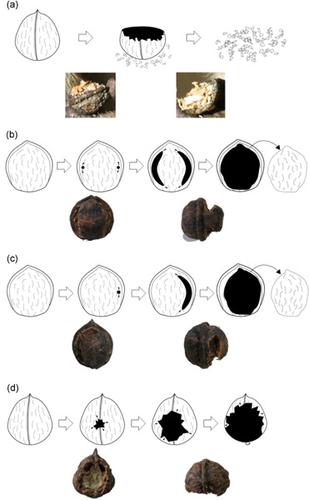当前位置:
X-MOL 学术
›
Am. J. Primatol.
›
论文详情
Our official English website, www.x-mol.net, welcomes your
feedback! (Note: you will need to create a separate account there.)
Extractive foraging on hard-shelled walnuts and variation of feeding techniques in wild Japanese macaques (Macaca fuscata).
American Journal of Primatology ( IF 2.0 ) Pub Date : 2020-04-15 , DOI: 10.1002/ajp.23130 Masaya Tamura 1
American Journal of Primatology ( IF 2.0 ) Pub Date : 2020-04-15 , DOI: 10.1002/ajp.23130 Masaya Tamura 1
Affiliation

|
Extractive foraging is considered a key selective pressure for the evolution of primate cognitive abilities-the extractive foraging hypothesis. Although tool-use and substrate-use are representatives of the foraging strategy, some primates engage in extractive foraging without external objects. Manual processing skills of prickly foods have been described in some species, whereas there are few studies on other type of food defenses. Here, I describe extractive foraging of hard-shelled walnuts by wild Japanese macaques (Macaca fuscata), focusing on whether they accomplish the tasks only by their physical strength or require manual and/or oral processing skills to crack open the walnut shells. The study subjects comprised all members of troop B1 and three nontroop males in Kinkazan Island, Japan. Walnut feeding was observed during the main walnut seasons (September-December) when the troop visited walnut patches for 79 days in 2 years. I categorized the walnut feeding behavior into complete cracking and partial cracking. The number of times the five behavioral elements in the cracking stage occurred were counted from complete cracking. All six adult males and 11 of the 17 adult/adolescent females showed complete cracking, while the remaining females were never observed exhibiting this activity, despite their physical maturity. I observed four clearly distinguishable cracking methods during walnut feeding in the 17 subjects. The compositions of five behavioral elements were different in each method. These results suggest that walnut feeding by Japanese macaques is not only by brute force but requires the acquisition of at least one of four cracking methods for the achievement of complete cracking. In particular, females need to compensate for their physical inferiority by increasing walnut manipulations. To my knowledge, this is the first detailed description on feeding techniques in primates to overcome hard-shelled obstacles without the use of tools and even substrates.
中文翻译:

在野生日本猕猴(Macaca fuscata)上对硬壳核桃进行的觅食觅食和饲养技术的变化。
提取觅食被认为是灵长类动物认知能力发展的关键选择压力-提取觅食假说。尽管工具使用和底物使用是觅食策略的代表,但是一些灵长类动物在没有外部物体的情况下从事采掘觅食。在某些物种中已经描述了多刺食物的手工加工技能,而关于其他类型的食物防御措施的研究很少。在这里,我描述了野生猕猴(Macaca fuscata)对硬壳核桃的提取觅食,重点是它们是仅凭自身的体力完成任务还是需要手工和/或口头加工技能才能打开核桃壳。研究对象包括日本Kinkazan岛的所有B1部队成员和三名非部队男性。在主要核桃季节(9月至12月)观察到核桃饲喂,当时部队在2年内访问了核桃补丁达79天。我将核桃的进食行为分为完全开裂和部分开裂。从完全破解中计算出在破解阶段中五个行为要素发生的次数。所有六个成年男性和17个成年/青春期女性中的11个都显示出完全的开裂,而其余的女性尽管身体成熟,但从未观察到有这种活动。我在17位受试者的核桃喂养过程中观察到四种明显不同的开裂方法。在每种方法中,五个行为要素的组成都不同。这些结果表明,日本猕猴不仅通过蛮力喂食核桃,而且还需要获得至少四种破碎方法中的一种才能完全破碎。特别是,女性需要通过增加胡桃木的操作来弥补自己的自卑。据我所知,这是关于灵长类动物在不使用工具甚至不使用工具的情况下克服硬壳障碍的进食技术的第一个详细说明。
更新日期:2020-04-15
中文翻译:

在野生日本猕猴(Macaca fuscata)上对硬壳核桃进行的觅食觅食和饲养技术的变化。
提取觅食被认为是灵长类动物认知能力发展的关键选择压力-提取觅食假说。尽管工具使用和底物使用是觅食策略的代表,但是一些灵长类动物在没有外部物体的情况下从事采掘觅食。在某些物种中已经描述了多刺食物的手工加工技能,而关于其他类型的食物防御措施的研究很少。在这里,我描述了野生猕猴(Macaca fuscata)对硬壳核桃的提取觅食,重点是它们是仅凭自身的体力完成任务还是需要手工和/或口头加工技能才能打开核桃壳。研究对象包括日本Kinkazan岛的所有B1部队成员和三名非部队男性。在主要核桃季节(9月至12月)观察到核桃饲喂,当时部队在2年内访问了核桃补丁达79天。我将核桃的进食行为分为完全开裂和部分开裂。从完全破解中计算出在破解阶段中五个行为要素发生的次数。所有六个成年男性和17个成年/青春期女性中的11个都显示出完全的开裂,而其余的女性尽管身体成熟,但从未观察到有这种活动。我在17位受试者的核桃喂养过程中观察到四种明显不同的开裂方法。在每种方法中,五个行为要素的组成都不同。这些结果表明,日本猕猴不仅通过蛮力喂食核桃,而且还需要获得至少四种破碎方法中的一种才能完全破碎。特别是,女性需要通过增加胡桃木的操作来弥补自己的自卑。据我所知,这是关于灵长类动物在不使用工具甚至不使用工具的情况下克服硬壳障碍的进食技术的第一个详细说明。











































 京公网安备 11010802027423号
京公网安备 11010802027423号